April 22 marked the 52nd anniversary of Earth Day, originally in 1970 a teach-in on college campuses to raise awareness of the environment. That movement led to bipartisan efforts in the 1970s like the creation of the Environmental Protection Agency, the Clean Air Act and the Clean Water Act.
Here in Homer, the Kachemak Bay Conservation Society held an Earth Day celebration at Bishop’s Beach, with a barbecue, music and a scavenger hunt. Events like that are in the spirit of the idea, but for me, I like to celebrate Earth Day by going birding.
I remember high school in 1973, when schools in Hillsborough Couny, Florida, held a big Earth Day rally during the class day. To attend you had to earn ecological points by doing things like recycling aluminum cans or riding your bike to school. Students jumped at any chance to skip classes, and if they could do so with official permission, so much the better.
Supposedly thousands would be attending the event. When I got to the rally, maybe a hundred students had showed up. I ran into a friend who went to a different school, and when I asked Henry where everyone had gone, he said, “Oh, we’re all going to the beach. I just came by in case I had to sign in.”
Looking back, actually going to a place close to nature instead of an event with lots of speechifying might have been more in the spirit of the day. “Going to the beach” as a Florida teenager meant basking in the sun, playing Frisbee and looking at scantily clad young people, many of them quite attractive.
For me, Florida beaches immersed me in nature. I avoided the crowded places near hotels and sought out quieter places like Ft. Desoto Park near St. Petersburg. I looked for dunes covered with beach grass and areas thick with wildlife — especially birds.
I didn’t go full on bird nerd until I moved to Alaska, but the seed was planted on those Florida beaches with gulls, shorebirds and blue herons.
When spring in Alaska comes, I become more intent on birding. I am not a foul weather birder, one who will brave the cold for the Christmas Bird Count trying to tag as many species as possible. In mid-April as the daylight hours become longer, the snow melts and the ice thaws, I get out my binoculars, spotting scope, guide books and birding log.
On my lunch breaks, I hit my favorite birding spots in town. There’s the Mariner Park beach, of course, where I take my daily walks. I might head out to Green Timbers or Louie’s Lagoon on the Homer Spit, always a good place to look for shorebirds.
As I drive over Beluga Lake on the causeway, I check out the lake or the slough. I might go to Bishop’s Beach and walk the boardwalk there along Beluga Slough, scanning the ponds and wetlands.
I start listening, too, because many birds — like the varied thrush or yellowlegs — first make their presence known by their calls. I usually hear a varied thrush first, that distinct trill that sounds like a 20th century telephone ringing. If you listen closely and zero in on the thrush, you might see it on the top of spruce trees.
The yellowlegs come next, that excited wheet-wheet-wheet sound of its alarm when it gets surprised. They will be either greater or lesser yellowlegs, and although I know the difference, when I see them alone I have to puzzle them out. My heart always does a little dance, because yellowlegs are shorebirds, the first one of the migration, and I really, really love shorebirds.
I might also notice bald eagles building nests, like the pair that hangs out by Beluga Slough across from the Lake Street stoplight. For some reason, that pair hasn’t begun to build its nest this year, or it has started a nest away from the one in the big spruce tree that’s been its home for the past five years.
When Beluga Lake goes out, or open water forms, I looked for trumpeter swans. Sure enough, last week on April 13 I saw a pair at the northwest corner of the lake where the Sterling Highway makes the turn toward Lake Street. They showed up again on Monday, April 18, when they flew by the Homer News, squawked a bit and plomped down on the ice.
The artist Mavis Muller — a self-proclaimed “crainiac” — says that traditionally sandhill cranes show up on Earth Day. There were reports early last week on the Kachemak Bay Birders email list of people hearing cranes. I did a recon Thursday of Beluga Slough at the end of East Bunnell Avenue. A nesting pair of cranes returns every year to the area by the boardwalk. Alas, no cranes had shown up.
But then on Friday after work I looked again, and sure enough, on April 22 once again, six sandhill cranes landed on the east side of Beluga Slough. Still in their gray coloring, they had not yet started to daub orange mud on their fathers, a camoflage technique called “painting.” On Monday I saw another pair at the Mariner Park lagoon by Lighthouse Village.
The sandhill cranes have arrived, as many more birds will come: western sandpipers and snipes and golden crowned sparrows and all the birds of spring. I will celebrate Earth Day every day with each new bird that returns. It’s a rough life for those migrating birds, but they persevere despite humans making life harder for them. That they return speaks to the resiliency of nature, but also to the hope that we won’t mess up the world further.
Happy Earth Day.
Reach Michael Armstrong at marmstrong@homernews.com.


